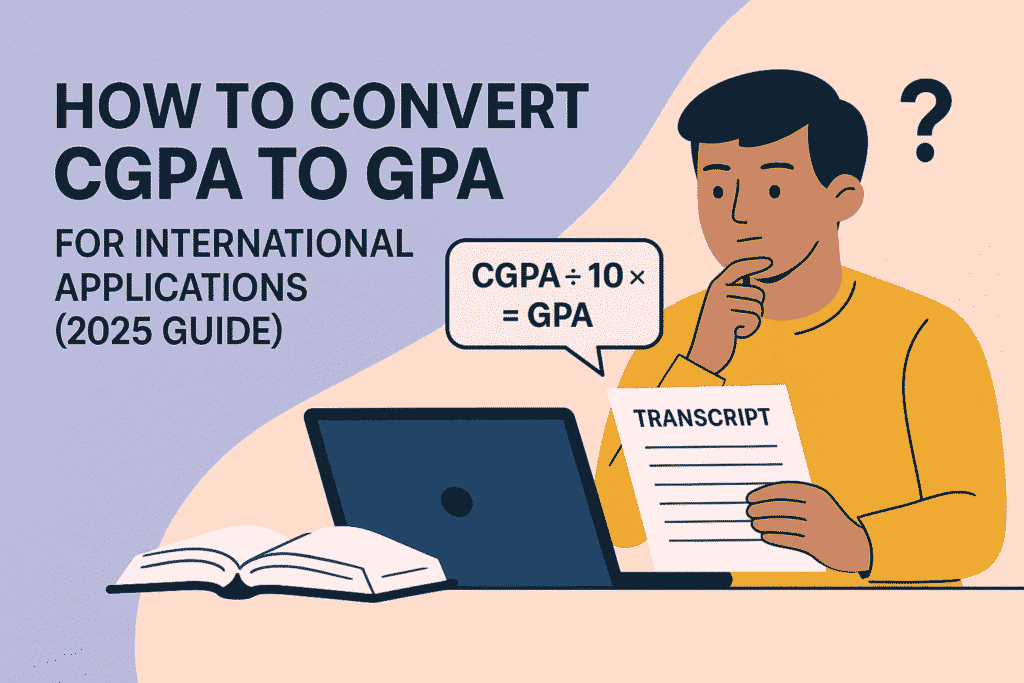Introduction
If you’re planning to study abroad, converting your Indian CGPA to GPA is crucial. Most universities in the US, Canada, and Europe follow the GPA scale, and understanding this conversion helps in presenting your academic profile accurately. This blog breaks down the step-by-step process to convert your CGPA to GPA for 2025 university applications.
1. What is CGPA and GPA?
-
CGPA (Cumulative Grade Point Average): A 10-point grading system used in Indian universities.
-
GPA (Grade Point Average): A 4-point scale common in American and European institutions.
Understanding the scales is important before attempting a conversion. CGPA is cumulative across all semesters, while GPA often reflects a weighted average per semester or year.
2. Why Conversion is Necessary for International Studies
Most international universities require GPA as part of the admission process. Directly submitting CGPA may lead to misinterpretation of your academic performance. Standardizing your marks improves your application accuracy and credibility.
✅ Tip: Always convert CGPA to GPA using the university’s official guideline if available. If not, use a standard formula (see below).
3. Common Conversion Formula (Unofficial)
While there’s no official one-size-fits-all formula, the following method is widely accepted:
Example:
If your CGPA is 8.5 out of 10:GPA = (8.5/10) × 4 = 3.4 on a 4.0 scale
📌 Note: This is just a rough approximation. Some universities may use WES (World Education Services) or in-house evaluators.
4. Use WES iGPA Calculator (Recommended)
World Education Services (WES) offers a tool called the iGPA Calculator which helps convert your Indian grades into an estimated US GPA.
Steps:
-
Visit the iGPA calculator tool.
-
Select India as the country.
-
Enter your marks or percentage.
-
Get the estimated GPA based on your transcripts.
This method is more reliable as WES is often accepted by US and Canadian universities.
5. Percentage-Based Conversion for Indian Students
Many Indian universities also issue percentages. You can convert your percentage to GPA roughly as:
| Percentage | GPA (Approx.) |
|---|---|
| 90–100% | 4.0 |
| 80–89% | 3.7 |
| 70–79% | 3.3 |
| 60–69% | 3.0 |
| 50–59% | 2.7 |
⚠️ Important: This table is a guideline. Always confirm with your target university.
6. University-Specific GPA Policies
Every university has its own standards. For example:
-
University of Toronto (Canada): May ask for percentage rather than GPA.
-
University of Michigan (USA): Accepts WES-evaluated GPA.
-
TU Munich (Germany): Requires CGPA but has its own assessment method.
🔍 Action Step: Always check the admissions page of your target university for their grading equivalency policy.
7. Should You Get Official Evaluation?
Yes. If your university abroad requires or recommends credential evaluation, you should use organizations like:
These services provide university-recognized GPA equivalents.
8. Documents You’ll Need
To convert and evaluate your GPA:
-
Official transcripts (all semesters)
-
Degree certificate (if available)
-
Grading scale used by your university
-
Identity documents (passport, Aadhaar, etc.)
🗂️ Keep digital copies ready for upload.
9. Can You Apply Without GPA Conversion?
In some cases — YES.
-
Many European countries (Germany, France) and Asian countries (Japan, South Korea) accept CGPA directly.
-
Some universities in the UK prefer percentage-based applications.
But for the US and Canada, GPA is often mandatory or highly recommended.
10. Summary: Your Conversion Checklist
✅ Check if your target university requires GPA.
✅ Use the WES iGPA calculator or university-specific formula.
✅ Ensure all transcripts and grading scale documents are accurate.
✅ If required, get a WES or ECE evaluation done.
✅ Never guess your GPA — always estimate or calculate properly.
Helpful Links for Your Blog
-
WES iGPA Calculator: https://applications.wes.org/igpa-calculator/
-
WES Home: https://www.wes.org/
-
ECE Home: https://www.ece.org/
-
IQAS Credential Assessment (Canada): https://www.alberta.ca/iqas.aspx
Conclusion
Converting your CGPA to GPA may seem complex at first, but with the right tools and approach, it’s a smooth process. Always verify what your university requires, use official tools, and be transparent in your academic documents. This small effort can make a big difference in your international admission journey.

